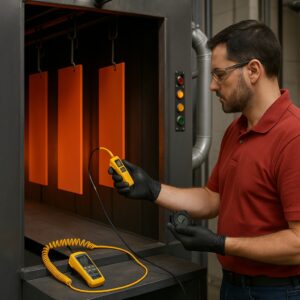Flawless finishes don’t happen by chance—they come from a mix of solid craftsmanship and precise machine settings. In powder coating, one skipped step or miscalibration can throw off the entire production line. For those aiming for dependable results, these quality-control checkpoints make all the difference.

Machine Temperature Calibration
The coating process depends heavily on accurate and steady temperature control. If the internal environment is too hot, the powder may overbake, leading to discoloration or brittleness. Too cold, and the finish can remain undercured, resulting in poor adhesion and reduced durability. Consistency here comes from routine temperature checks—verified with calibrated instruments instead of relying on a display panel alone.
A powder coating machine should be checked at multiple points inside the chamber to ensure there are no hot or cold zones. Inconsistent heat distribution can affect batch-to-batch reliability, especially with complex parts or varying thicknesses. Maintaining the right temperature baseline sets the stage for finishes that meet exact specifications every time.
Pre-Set Cure Time Verification
Even with a perfectly calibrated machine, time matters just as much as temperature. The pre-set cure duration must align with the powder manufacturer’s specifications. If the timing is off, coatings can fail before they ever leave the facility. Verifying that the equipment holds parts at the ideal temp for the right duration is critical to performance and appearance.
To stay consistent, operators should use manual timers as a backup to digital readouts. Tracking cycle length from entry to exit ensures that no shortcuts occur due to operator oversight or equipment lag. Regular reviews of these settings give your team peace of mind that coatings are cured thoroughly, delivering lasting protection and a flawless surface.
Airflow Optimization
A uniform finish relies on proper airflow within the chamber. Balanced circulation ensures that heat wraps around the part evenly, preventing areas that are undercooked or scorched. If the airflow isn’t consistent, even a properly applied powder can behave unpredictably—creating uneven textures, gloss levels, or cure quality.
Optimizing airflow also prevents build-up on corners and edges, which are particularly sensitive to coating inconsistencies. A well-functioning powder coating machine moves air in a controlled pattern, distributing heat and particles in a balanced, predictable way. Adjusting louvers, checking fans, and running flow tests keeps everything in sync for smoother, cleaner results.
Exhaust System Functionality Check
While airflow distributes heat, the exhaust system controls air quality and pressure. If this part of the machine isn’t functioning properly, internal temperatures can spike or drop unexpectedly. Worse, improper exhaust pulls particles through the chamber, contaminating parts or creating safety hazards for the crew.
Testing exhaust strength and cleaning out buildup are standard quality steps that directly affect how the powder coating machine performs. A clogged or weak exhaust creates unwanted pressure fluctuations, leading to poor coverage and inconsistent curing. Keeping this system clean and responsive is key to maintaining a safe, stable, and repeatable finish.
Part Loading Density Management
Loading parts into the chamber may seem simple, but it directly impacts finish quality. If parts are packed too tightly, airflow becomes restricted, and some surfaces may not receive enough heat. That can lead to uneven curing and dull patches. On the other hand, spreading parts too far apart wastes energy and slows production efficiency.
Operators should use consistent spacing templates or fixtures to standardize loading density. This small adjustment ensures each surface gets equal exposure to the heat and airflow, creating a predictable result. Repeatable loading practices help your powder coating machine maintain its rhythm and reduce variability across runs.
Cool-Down Rate Monitoring
The cool-down stage isn’t just about waiting for parts to reach room temperature. It’s part of the curing process itself. Rapid cooling can cause stress cracks or distort the finish, especially on delicate components or complex assemblies. A slow, even cool-down ensures the coating bonds properly and settles into a durable final layer.
Monitoring the rate of temperature drop inside the machine helps confirm that parts aren’t exposed to abrupt changes. This process also protects metal from warping due to thermal shock. Tracking the cool-down curve and adjusting venting or timing as needed is a small but essential move that can prevent failures after parts leave the line.
Preventive Maintenance Schedule Adherence
Machines don’t stay perfect without a little care. Preventive maintenance is more than just tightening screws—it’s a full checklist that includes inspecting sensors, cleaning nozzles, calibrating controls, and testing safety interlocks. Each of these tasks contributes to reliable performance and long-term consistency.
Keeping a log and following a set schedule keeps your powder coating machine running at its peak. Unexpected issues like electrical faults, pressure leaks, or heating fluctuations often stem from skipped maintenance. A little time spent on routine checkups avoids major downtime and ensures each part coming out looks as flawless as the last.




Leave a Reply